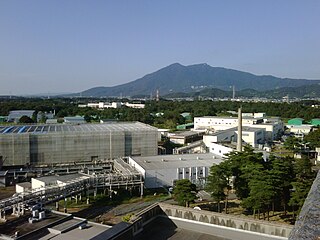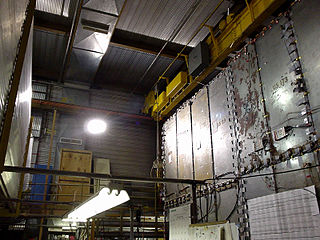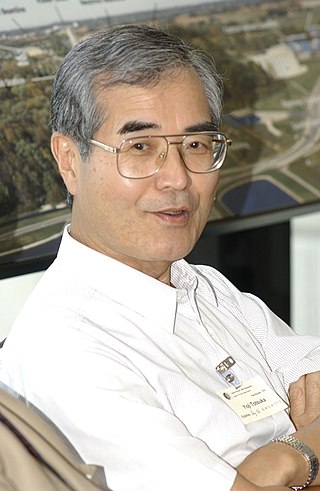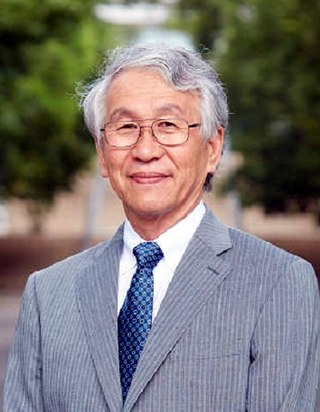
Gargamelle was a heavy liquid bubble chamber detector in operation at CERN between 1970 and 1979. It was designed to detect neutrinos and antineutrinos, which were produced with a beam from the Proton Synchrotron (PS) between 1970 and 1976, before the detector was moved to the Super Proton Synchrotron (SPS). In 1979 an irreparable crack was discovered in the bubble chamber, and the detector was decommissioned. It is currently part of the "Microcosm" exhibition at CERN, open to the public.

The High Energy Accelerator Research Organization, known as KEK, is a Japanese organization whose purpose is to operate the largest particle physics laboratory in Japan, situated in Tsukuba, Ibaraki prefecture. It was established in 1997. The term "KEK" is also used to refer to the laboratory itself, which employs approximately 695 employees. KEK's main function is to provide the particle accelerators and other infrastructure needed for high-energy physics, material science, structural biology, radiation science, computing science, nuclear transmutation and so on. Numerous experiments have been constructed at KEK by the internal and international collaborations that have made use of them. Makoto Kobayashi, emeritus professor at KEK, is known globally for his work on CP-violation, and was awarded the 2008 Nobel Prize in Physics.

Maurice Goldhaber was an American physicist, who in 1957 established that neutrinos have negative helicity.

Soudan 2 was a particle detector located in the Soudan Mine in Northern Minnesota, United States, that operated from 1989 to 2001. It was a 960-ton iron tracking calorimeter whose primary purpose was to search for proton decay, although its data was also used to investigate the properties of neutrinos. It found no evidence of proton decay, but it did help confirm Super-Kamiokande's atmospheric neutrino result, supporting the theory of neutrino oscillation.
T2K is a particle physics experiment studying the oscillations of the accelerator neutrinos. The experiment is conducted in Japan by the international cooperation of about 500 physicists and engineers with over 60 research institutions from several countries from Europe, Asia and North America and it is a recognized CERN experiment (RE13). T2K collected data within its first phase of operation from 2010 till 2021. The second phase of data taking (T2K-II) is expected to start in 2023 and last until commencement of the successor of T2K – the Hyper-Kamiokande experiment in 2027.

Hyper-Kamiokande is a neutrino observatory and experiment under construction, conducted in Japan by the collaboration of institutes from 21 countries from six continents. As a successor of the Super-Kamiokande (SK) and T2K experiments, it is designed to search for proton decay and detect neutrinos from natural sources such as the Earth, the atmosphere, the Sun and the cosmos, as well as to study neutrino oscillations of the man-made accelerator neutrino beam. The beginning of data-taking is planned for 2027.
The Kamioka Observatory, Institute for Cosmic Ray Research is a neutrino and gravitational waves laboratory located underground in the Mozumi mine of the Kamioka Mining and Smelting Co. near the Kamioka section of the city of Hida in Gifu Prefecture, Japan. A set of groundbreaking neutrino experiments have taken place at the observatory over the past two decades. All of the experiments have been very large and have contributed substantially to the advancement of particle physics, in particular to the study of neutrino astronomy and neutrino oscillation.
The timeline of particle physics lists the sequence of particle physics theories and discoveries in chronological order. The most modern developments follow the scientific development of the discipline of particle physics.

Yoji Totsuka was a Japanese physicist and Special University Professor, Emeritus, University of Tokyo. A leader in the study of solar and atmospheric neutrinos, he was a scientist and director at Kamioka Observatory, Super-Kamiokande and the High Energy Physics Laboratory (KEK) in Japan.
The K2K experiment was a neutrino experiment that ran from June 1999 to November 2004. It used muon neutrinos from a well-controlled and well-understood beam to verify the oscillations previously observed by Super-Kamiokande using atmospheric neutrinos. This was the first positive measurement of neutrino oscillations in which both the source and detector were fully under experimenters' control. Previous experiments relied on neutrinos from the Sun or from cosmic sources. The experiment found oscillation parameters which were consistent with those measured by Super-Kamiokande.

Soo-Bong Kim is a South Korean physicist.

The Accelerator Neutrino Neutron Interaction Experiment (ANNIE) is a proposed water Cherenkov detector experiment designed to examine the nature of neutrino interactions. This experiment will study phenomena like proton decay, and neutrino oscillations, by analyzing neutrino interactions in gadolinium-loaded water and measuring their neutron yield. Neutron Tagging plays an important role in background rejection from atmospheric neutrinos. By implementing early prototypes of LAPPDs, high precision timing is possible. The suggested location for ANNIE is the SciBooNE hall on the Booster Neutrino Beam associated with the MiniBooNE experiment. The neutrino beam originates in Fermilab where The Booster delivers 8 GeV protons to a beryllium target producing secondary pions and kaons. These secondary mesons decay to produce a neutrino beam with an average energy of around 800 MeV. ANNIE will begin installation in the summer of 2015. Phase I of ANNIE, mapping the neutron background, completed in 2017. The detector is being upgraded for full science operation which is expected to begin late 2018.
Charles Young Prescott is an American particle physicist.
Paul Dutton Grannis is an American physicist.

Atsuto Suzuki is an experimental particle physicist known for his observations of neutrinos and anti-neutrinos.
Kōichirō Nishikawa was a Japanese elementary particle physicist, known for contributions to neutrino physics. He was professor emeritus of the KEK high-energy physics laboratory and Kyōto University.
An accelerator neutrino is a human-generated neutrino or antineutrino obtained using particle accelerators, in which beam of protons is accelerated and collided with a fixed target, producing mesons which then decay into neutrinos. Depending on the energy of the accelerated protons and whether mesons decay in flight or at rest it is possible to generate neutrinos of a different flavour, energy and angular distribution. Accelerator neutrinos are used to study neutrino interactions and neutrino oscillations taking advantage of high intensity of neutrino beams, as well as a possibility to control and understand their type and kinematic properties to a much greater extent than for neutrinos from other sources.
Karol Sylwester Lang is an experimental particle physicist and the Jane and Roland Blumberg Professor of Physics at the University of Texas at Austin.









